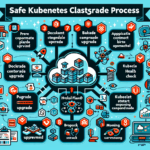Backing up and restoring Kubernetes clusters is a critical task for maintaining the availability and integrity of your applications and data. Below, I’ll outline the key components to back up, tools you can use, and the steps to perform backup and restore operations.
Key Components to Back Up
- etcd Database
- Stores the cluster state, including secrets, configurations, service accounts, and more.
-
Critical to back up as it is the “brain” of the Kubernetes cluster.
-
Persistent Volumes (PV)
-
Contains application data stored on external storage systems.
-
Kubernetes Manifests and Configurations
-
Includes deployments, services, config maps, secrets, custom resource definitions (CRDs), etc.
-
Cluster Add-ons
- Backup any additional cluster configurations, such as ingress controllers, networking policies, and monitoring tools.
Backup and Restore Tools
Here are some popular tools for Kubernetes backup and restoration:
- Velero
-
Open-source tool for backing up and restoring Kubernetes cluster resources and persistent volumes.
-
Kasten K10
-
Enterprise-grade backup and disaster recovery solution.
-
TrilioVault
-
Kubernetes-native backup and recovery tool.
-
Stash
-
A backup tool that supports various workloads and persistent volumes.
-
Custom Scripts
-
Use
kubectlcommands andetcdutilities for manual backups. -
Cloud Provider Snapshots
- If using a managed Kubernetes service (e.g., AWS EKS, Azure AKS, GKE), leverage the provider’s built-in backup and snapshot tools.
Backing Up Kubernetes Clusters
1. Backing Up etcd
- For a self-managed cluster:
bash
ETCDCTL_API=3 etcdctl snapshot save /path/to/backup/etcd-snapshot.db \
--endpoints=<etcd-endpoint> \
--cert=<path-to-client-cert> \
--key=<path-to-client-key> \
--cacert=<path-to-ca-cert> -
Store the snapshot in a secure, redundant location (e.g., S3, NFS, or other backup storage).
-
In managed services, etcd backups may already be automated by the provider.
2. Backing Up Application Resources
- Use
kubectlto export resources:
bash
kubectl get all --all-namespaces -o yaml > cluster-backup.yaml
kubectl get pv,pvc,configmap,secret --all-namespaces -o yaml >> cluster-backup.yaml
3. Backing Up Persistent Volumes
- Use Velero or another tool to take snapshots of PVs.
- Alternatively, use your storage provider’s snapshot or replication features.
4. Automating Backups
- Schedule regular backups using tools like Velero or cron jobs.
- Example with Velero:
bash
velero backup create <backup-name> --include-namespaces <namespace-name>
Restoring Kubernetes Clusters
1. Restoring etcd
- Stop the Kubernetes API server.
- Restore the etcd snapshot:
bash
ETCDCTL_API=3 etcdctl snapshot restore /path/to/backup/etcd-snapshot.db \
--data-dir=/var/lib/etcd - Restart etcd and the API server.
2. Restoring Application Resources
- Apply the exported YAML files:
bash
kubectl apply -f cluster-backup.yaml
3. Restoring Persistent Volumes
- Use Velero or the storage provider’s snapshot/restore mechanisms to restore data.
4. Validating the Restore
- Verify that all resources are restored and running as expected:
bash
kubectl get pods --all-namespaces
kubectl describe <resource-type> <resource-name>
Best Practices for Backup and Restore
- Automate and Schedule Backups
-
Use tools like Velero to automate backups and set up a regular schedule.
-
Test Restores Regularly
-
Periodically test the restore process to ensure it works as expected.
-
Store Backups Securely
-
Encrypt backups and store them in a remote, secure location with redundancy.
-
Backup Multiple Components
-
Include etcd, manifests, and persistent volumes in your backup strategy.
-
Monitor Backups
-
Use monitoring tools to ensure backups are completing successfully.
-
Version Compatibility
- Ensure that the Kubernetes version during the restore is compatible with the version used during the backup.
By following these steps and practices, you can ensure that your Kubernetes clusters are backed up properly and can be restored quickly in case of failures.



